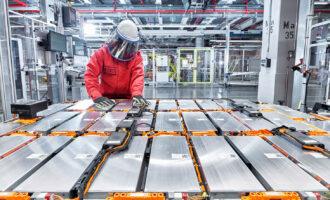
Post-2020 CO2 targets: Time for a reality check?
Mandatory emission reduction targets for European vehicles come into effect in less than three years. By 2021, phased in from 2020, fleet averages for all new cars must not exceed 95 grams of carbon dioxide (CO2) per kilometer. For many auto manufacturers, achieving the 2021 target remains a challenge with some still looking around for those extra grams to avoid paying penalties. By the time the new fleet average takes effect, new car CO2 emissions will be 42% lower than in 2005.
Despite the difficulty of achieving impending targets, the European Union has already shifted its focus to the future of CO2 regulations. On November 8, 2017, the European Commission published a proposal on new emissions standards for passenger cars and light commercial vehicles (LCVs) post-2020. The legislature recommends a 30% reduction in CO2 by 2030, from a 2021 baseline. Locking down post-2020 emissions targets is a pressing issue with the election of a new European Parliament looming early next year. Discussion amongst European environmental ministers and key voting will take place over the next couple of months.
However, the European Automobile Manufacturers Association (ACEA) opposes the EU’s newly proposed target, offering a “more realistic” target of 20%. ACEA represents the interests of 15 major European-based car, van, truck and bus manufacturers. The organisation also raised additional concerns including a proposed mid-term 2025 benchmark, lower thresholds for eco innovations, and light commercial vehicle targets.
Certainly, regulatory bodies the world over are ramping up efforts to curb CO2 emissions, though, displeased automobile manufacturers may be justified in their concerns. Paul Greening, ACEA director of Emissions & Fuels, speaking at the UNITI Forum in Stuttgart, Germany, in April 2018, declared that the transport industry has been treated “disproportionately.”

Greening, presenting “Future Powertrains and Influence on Fuels and Lubricant Needs,” highlighted that transport accounts for roughly 24% of total European greenhouse gas emissions. More specifically, road transport generates only 17%. Despite this, he says, regulators focus heavily on road transport — which is in many ways the most expensive way to address CO2 reduction. “We certainly believe there are more cost-effective ways to reduce transport CO2 or CO2 in general,” says the ACEA representative.
Irrespective, no other sector has made as much progress as the transport industry in combating CO2, he says. From 2005 to 2020 emissions for new cars will have been reduced by 42%. The energy and industry sector posted barely half these reductions at 21%. Aviation delivers a meagre 5% in the same period. Yet still, the transport industry is pressed for further gains, he says.
While ACEA remains committed to decarbonisation, Greening is wary of several major challenges facing the industry moving forward. During the presentation, he outlined several regulatory activities that will “alter the playing field under which the auto industry will be operating.”
The new WLTP (Worldwide Harmonised Light Vehicle Test Procedure) emissions test is a considerable obstacle, even when realising 2020 targets. The test is a more representative, more rigorous test, and “could add +5% CO2” when correlated with NEDC (New European Driving Cycle) values. While favourable of the change, Greening emphasises that the boundary conditions have changed — rendering the 2021 target of 95g CO2/km even more severe.
Sales of alternatively-powered cars are critical to achieving forthcoming CO2 goals. Optimising the internal combustion engine (ICE) alone will not be sufficient. Despite a range of different powertrains on the market that include battery electric vehicles (BEV), fuel-cell EVs, and plug-in hybrids, Greening has serious concerns about the electric market and believes it is “time for a reality check.” A Science for Policy report by the Joint Research Centre (JRC), the European Commission’s science and knowledge service, in December 2017 confirms that purchase price remains a major hurdle to widespread adoption of electric powertrains, alongside a lack of recharging infrastructure and short range. Recent ACEA data claims of approximately 100,000 charging points, 76% of which are clustered in just four countries (Germany, France, UK and the Netherlands). The JRC study also asserts that “attitudes towards electric cars in Europe have remained relatively stable in the last five years.”
These attitudes seem to be reflected in sales of electrically chargeable cars in the region. EVs still only assume 1.4% market share of total car sales, with sales growing in line with overall car sales growth. Further, ACEA suggests 85% of all electrically chargeable cars are sold in just six Western European countries with some of the highest GDPs. In lower GDP countries in Central and Eastern Europe, the market share remains close to zero. In a statement in June 2018, ACEA President and CEO of PSA Group, Carlos Tavares, said: “CO2 targets must be realistic, taking into account what people can really afford.” He says, “there is clearly a huge gap in Europe between today’s battery electric car sales and the [European] Commission’s benchmark.”
The diesel car market has taken a hammering in recent times. Clearly, the ‘diesel gate’ scandal hasn’t helped. However, Greening believes discrimination against modern diesel technology is a major obstacle to CO2 reduction. The latest generation of diesel vehicles emit significantly less CO2 than their equivalent petrol-powered vehicles. Any market driven or political move away from diesel cars (to petrol) will provide additional challenges to meeting future CO2 targets, he says. Still, Greening says there is a bright future for diesel and that newer, real driving emissions (RDE) compliant, Euro 6 diesel vehicles will continue to play a leading role in delivering low CO2 and pollutant emissions.
The European Commission has also turned its eye to heavy-duty (HD) transportation. A new piece of legislation requires CO2 to be assessed using a modeling approach that requires mandatory declarations on CO2 values for each truck. The commission has been working with the industry on the computer simulation tool “Vecto” since 2010, which takes into account variables that affect CO2 emissions of complete truck-trailer configurations.
ACEA expects CO2 targets for heavy duty in 2025 and 2030 which “we trust will be based on work done” i.e. gCO2/passenger-km or gCO2/ tonne-km, and by type of heavy-duty application. Although the level of CO2 is currently unknown, Greening says “7% by 2025 and 16% by 2030 would be something that the industry could fairly address.” He also appealed for an integrated approach that considers vehicle-related measures, fleet renewal, alternative fuels and operations.
China is the world’s largest market and Greening submits they intend to become the leader in regulation making, with China VII a possibility in 2025. “Unfortunately,” Greening believes Europe will follow suit with a high likelihood of Euro 7. The need for Euro 7/VII must be justified by environmental need and assessing other sector contributions, he says, and future emission stages and feasibility must align with CO2 targets and dates. The move also provides an opportunity to consider new and more efficient ways to set out European emission regulations, particularly for HD, with the possible implementation of a global HD emissions standard.
Unveiling ACEA’s future powertrain vision to 2030, Greening confirmed that the ICE and advanced ICE (gasoline, diesel, natural gas, all with very low emissions) will remain dominant, alongside a gradual electrification of passenger vehicles. Despite the many billions invested in alternative powertrain technology, the market will not change overnight “or within the span of just a few years.” We need to continue to leverage a wide range of powertrain options to reduce CO2 effectively, says Greening, while also petitioning for lower-fossil or reduced carbon intensity liquid fuels to help contribute to lower CO2 emissions from transport and fuel production.







